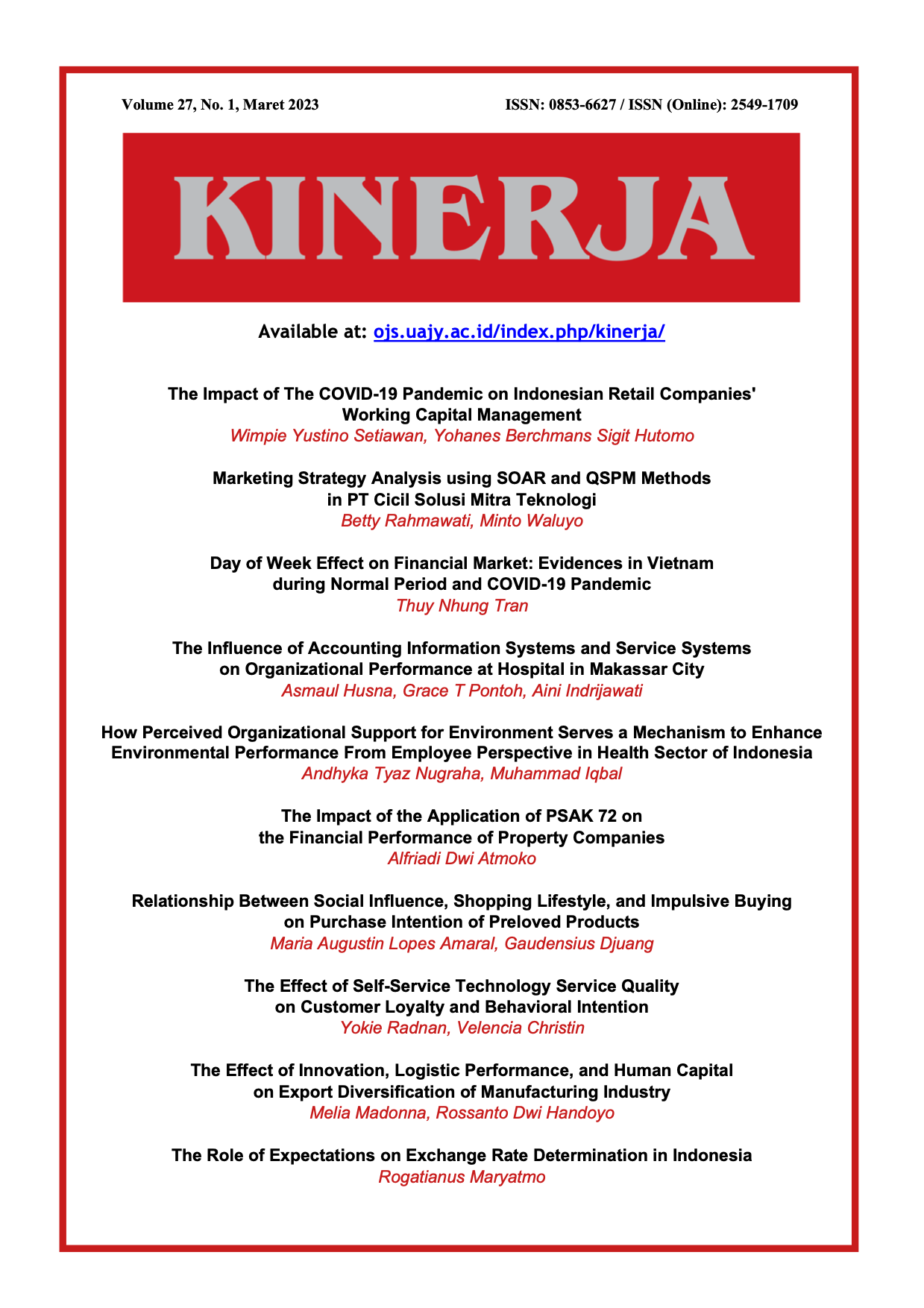The Effect of Self-Service Technology Service Quality on Customer Loyalty and Behavioral Intention
DOI:
https://doi.org/10.24002/kinerja.v27i1.6642Keywords:
self-service technology service quality, customer loyalty, behavioral intention, customer satisfactionAbstract
The purpose of this research is to know the effect of self-service technology service quality on customer loyalty, behavioral intention, and customer satisfaction, the effect of self-service technology service quality on customer loyalty and behavioral intention mediated by customer satisfaction, and the effect of self- service technology service quality on customer loyalty mediated by brand image. This study uses a quantitative approach using an online questionnaire data collection method (Google Form) and will be disseminated via social media (Line, WhatsApp, and Instagram). The sampling technique used in this study is non-probability sampling – purposive sampling with 218 respondents. The results of the research conducted prove that all hypotheses in the study are supported, including service quality self-service technology has a positive effect on customer loyalty, service quality self-service technology has a positive effect on behavioral intention, service quality self-service technology has a positive effect on customer satisfaction, customer satisfaction mediates the relationship between service quality self-service technology on customer loyalty positively, customer satisfaction mediates the relationship service quality self-service technology positively on behavioral intention, brand image mediates the relationship service quality self-service technology positively on customer loyalty.
References
Ayu, S., & Lahmi, A., 2020. Peran e-commerce terhadap perekonomian Indonesia selama pandemi covid-19. Jurnal Kajian Manajemen Bisnis, 9(2), 114. https://doi.org/10.24036/jkmb.10994100.
Basias, N., & Pollalis, Y., 2018. Quantitative and qualitative research in business & technology: Justifying a suitable research methodology. Review of Integrative Business and Economics Research, 7, 91–105. http://buscompress.com/journal-home.html.
Boon-itt, S., 2015. Managing self-service technology service quality to enhance e-satisfaction. International Journal of Quality and Service Sciences, 7(4), 373–391. https://doi.org/10.1108/IJQSS-01-2015-0013.
Cahyani, F. T., & Widati, S., 2021. The influence of behavior intention, personal autonomy, accessibility of information, and social support on the compliance of the use of ppe at PT. PLN. The Indonesian Journal of Public Health, 16(1). https://doi.org/10.20473/ijph.vl16il.2021.112-123.
Chen, C.-M., & Liu, H.-M., 2017. Exploring the impact of airlines service quality on customer loyalty: Evidence from taiwan. International Journal of Business and Management, 12(5), 36. https://doi.org/10.5539/ijbm.v12n5p36.
Ciputra, W., & Prasetya, W., 2020. Analisis pengaruh e-service quality, perceived value terhadap customer satisfaction, trust, dan customer behavioral intention. COMMENTATE: Journal of Communication Management, 1(2), 109. https://doi.org/10.37535/103001220201.
Familiar, K., & Maftukhah, I., 2015. Pengaruh kualitas produk dan kualitas pelayanan terhadap loyalitas pelanggan melalui kepuasan pelanggan. Management Analysis Journal, 4(4), 348–354.
Fauzi, M. R., & Mandala, K., 2019. Pengaruh kualitas pelayanan, kualitas produk, dan inovasi produk terhadap kepuasan untuk meningkatkan loyalitas pelanggan. E-Jurnal Manajemen Universitas Udayana, 8(11), 6741. https://doi.org/10.24843/ejmunud.2019.v08.i11.p18.
Hair, J. F., Babin, B. J., & Krey, N., 2017. Covariance-based structural equation modeling in the journal of advertising: review and recommendations. Journal of Advertising, 46(1), 163–177. https://doi.org/10.1080/00913367.2017.1281777.
Hair, J. F., Hult, G. T. M., Ringle, C. M., & Sarstedt, M., 2017. A Primer on Partial Least Squares Structural Equation Modeling (PLS-SEM) (2nd ed.). SAGE Publications, Inc.
Hair, J. F., Sarstedt, M., Hopkins, L., & Kuppelwieser, V. G., 2014. Partial least squares structural equation modeling (PLS-SEM): an emerging tool in business research. In European Business Review (Vol. 26, Issue 2, pp. 106– 121). Emerald Group Publishing Ltd. https://doi.org/10.1108/EBR-10-2013- 0128.
Henseler, J., Ringle, C. M., & Sarstedt, M., 2015. A new criterion for assessing discriminant validity in variance-based structural equation modeling. Journal of the Academy of Marketing Science, 43(1), 115–135. https://doi.org/10.1007/S11747-014-0403-8.
Irwansyah, A., & Mappadeceng, R., 2018. Pengaruh e-service quality terhadap customer loyalty melalui customer satisfaction pada toko online bukalapak. Jurnal Manajemen Dan Sains, 3(2). https://doi.org/http://dx.doi.org/10.33087/jmas.v3i2.50.
Kotler, P., & Keller, K. L., 2012. Marketing Management. 14 edition. Pearson.
Kurniawan, S., & Chandra, R., 2020. The effect of service quality, and promotion of satisfaction in mediation brand image. Marketing Management, 16, 1–15. http://repository.stei.ac.id/id/eprint/1333.
Machfiroh, I. S., 2018. Keterkaitan citra merek dan harga terhadap keputusan pembelian pada emak di fried chicken pelaihari. Jurnal Humaniora Teknologi 4(1), 2614–3682. https://doi.org/https://doi.org/10.34128/jht.v4i1.43
Memon, M. A., Ting, H., Cheah, J.-H., Thurasamy, R., Chuah, F., & Cham, T. H., 2020. Sample size for survey research: review and recommendations. Journal of Applied Structural Equation Modeling, 4(2), i–xx. https://doi.org/10.47263/jasem.4(2)01.
Narteh, B., 2015. Perceived service quality and satisfaction of self-service technology: The case of automated teller machines. International Journal of Quality and Reliability Management, 32(4), 361–380. https://doi.org/10.1108/IJQRM-08-2012-0113.
Nurdianasari, R., & Indriani, F., 2021. Study of perceived online convenience and customer satisfaction toward behavioral intention in online shopping. International Journal of Economics, Business and Accounting Research (IJEBAR), 5(2), 399–409. https://jurnal.stie-aas.ac.id/index.php/IJEBAR.
Nurhidayati, & Anam, A. K., 2019. Manajemen Bisnis Di Era Pandemi Covid-19 & New Normal. Unissula Press.
Nurlela, 2021. E-commerce, solusi di tengah pandemi covid-19. Jurnal Simki Economic, 4(1), 47–56. https://doi.org/https://doi.org/10.29407/jse.v4i1.53
Pratiwi, L., Sunaryo, S., & Mugiono, M., 2021. The effect of e-service quality on e-loyalty mediated by e-trust and brand image variables. International Journal of Research in Business and Social Science, 10(6), 56–62. https://doi.org/10.20525/ijrbs.v10i6.1364.
Rahi, S., & Abd Ghani, M., 2018. Investigating the role of e-service quality and brand image in internet banking acceptance context with structural equation modeling (SEM-PLS). 30th International Scientific Conference on Economic and Social Development, 427–442. http://www.esd-conference.com.
Rahman, S., Fadrul, F., Yusrizal, Y., Marlyna, R., & Momin, M., 2022. Improving the satisfaction and loyalty of online shopping customers based on e- commerce innovation and e-service quality. Gadjah Mada International Journal of Business, 24(1), 56–81.
Rehatalanit, Y. L. R. (2016). Peran e-commerce dalam pengembangan bisnis. Jurnal Teknologi Industri, 5. https://doi.org/10.35968/jti.v5i0.764.
Rosana, F. C., 2022. Kemendag Terima 3.692 Aduan Sepanjang 2022, Mayoritas Konsumen E-commerce. Available at: https://bisnis.tempo.co/read/1610026/kemendag-terima-3-692-aduan-sepanjang-2022-mayoritas-konsumen-e-commerce.
Rosyidah, N., & Andjarwati, A. L., 2021. Pengaruh self-service technology quality terhadap loyalitas dengan kepuasan sebagai variabel mediasi. Journal IMAGE, 10(1), 14–27. https://doi.org/https://doi.org/10.17509/image.v10i1.31448.
Sari, K., 2020. Analisis pendekatan behavioral intention pada minat menggunakan mobile payment ovo. Jurnal Online Mahasiswa (JOM), 5(4). https://jom.unpak.ac.id/index.php/ilmumanajemen/article/view/1506.
Saricam, C., 2022. Analysing service quality and its relation to customer satisfaction and loyalty in sportswear retail market. Autex Research Journal, 22(2), 184–193. https://doi.org/10.2478/aut-2021-0014.
Sarstedt, M., Hair, J. F., Pick, M., Liengaard, B. D., Radomir, L., & Ringle, C. M., 2022. Progress in partial least squares structural equation modeling use in marketing research in the last decade. Psychology and Marketing, 39(5), 1035–1064. https://doi.org/10.1002/mar.21640
Sarstedt, M., Ringle, C. M., & Hair, J. F., 2017. Partial least squares structural equation modeling. Handbook of Market Research (pp. 1–40). Springer International Publishing. https://doi.org/10.1007/978-3-319-05542-8_15-1.
Schiffman, L. G., & Wisenblit, J. L., 2015. Consumer Behavior. (11th ed., Issue 6). Pearson Education Limited.
Schuberth, F., Rademaker, M. E., & Henseler, J., 2022. Assessing the overall fit of composite models estimated by partial least squares path modeling. European Journal of Marketing. https://doi.org/10.1108/EJM-08-2020-0586.
Sekaran, U., & Bougie, R., 2016. Research methods for business: A skill-building approach. Leadership & Organization Development Journal, 34 (7). https://doi.org/10.1108/lodj-06-2013-0079.
Shahid Iqbal, M., Ul Hassan, M., & Habibah, U., 2018. Impact of self-service technology (SST) service quality on customer loyalty and behavioral intention: The mediating role of customer satisfaction. Cogent Business and Management, 5(1). https://doi.org/10.1080/23311975.2018.1423770.
Statista, 2020a. Indonesia: Online Purchase Behavior During COVID-19 Pandemic 2020. Available at: https://www.statista.com/statistics/1127876/indonesia-impact- on-online-purchase-behavior-covid-19/.
Statista, 2020b. E-Commerce Users in Indonesia 2025. Available at: https://www.statista.com/forecasts/251635/e-commerce-users-in-indonesia
Statista, 2022. Indonesia: Leading E-Commerce Sites by Monthly Traffic 2022. Available at: https://www.statista.com/statistics/869700/indonesia-top-10-e- commerce-sites/.
Sukma Wijaya, B., 2013. Dimensions of brand image: A conceptual review from the perspective of brand communication. European Journal Business and Management, 5. https://doi.org/10.13140/ejbm.2013.55.65.
SurveySensum, 2022. E Commerce Trends Indonesia 2022. Available at: https://www.surveysensum.com/lp/Indonesia-E-Commerce-Trends-Report-2022.html.
Tanujaya, C., 2017. Perancangan standart operational procedure produksi pada perusahaan Coffeein. Performa: Jurnal Manajemen Dan Start-Up Bisnis, 2(1). https://journal.uc.ac.id/index.php/performa/article/view/441.
Top Brand, 2022. Top Brand Index. Available at: https://www.topbrand-award.com/top-brand- index/?tbi_find=Tokopedia.
Tripathi, K. K., & Jha, K. N. (2018). Determining success factors for a construction organization: A structural equation modeling approach. Journal of Management in Engineering, 34(1). https://doi.org/10.1061/(asce)me.1943- 5479.0000569.
Wahab, R. A., Nurdiyanah, R., Ahmad, F., & Shukri, Z., 2018. Perceived value, customers’ satisfaction and behavioural intention in relation to seafood restaurants in Johor Bahru. Malaysian Applied Biology, 47(4), 95–106.
Zeglat, D., Shrafat, F., & Al-Smadi, Z., 2016. international review of management and marketing the impact of the e-service quality of online databases on users’ behavioral intentions: A perspective of postgraduate Students. International Review of Management and Marketing, 6(1), 1–10. https://econjournals.com















